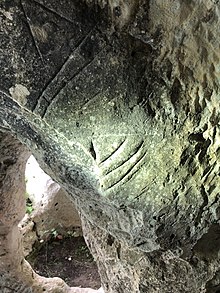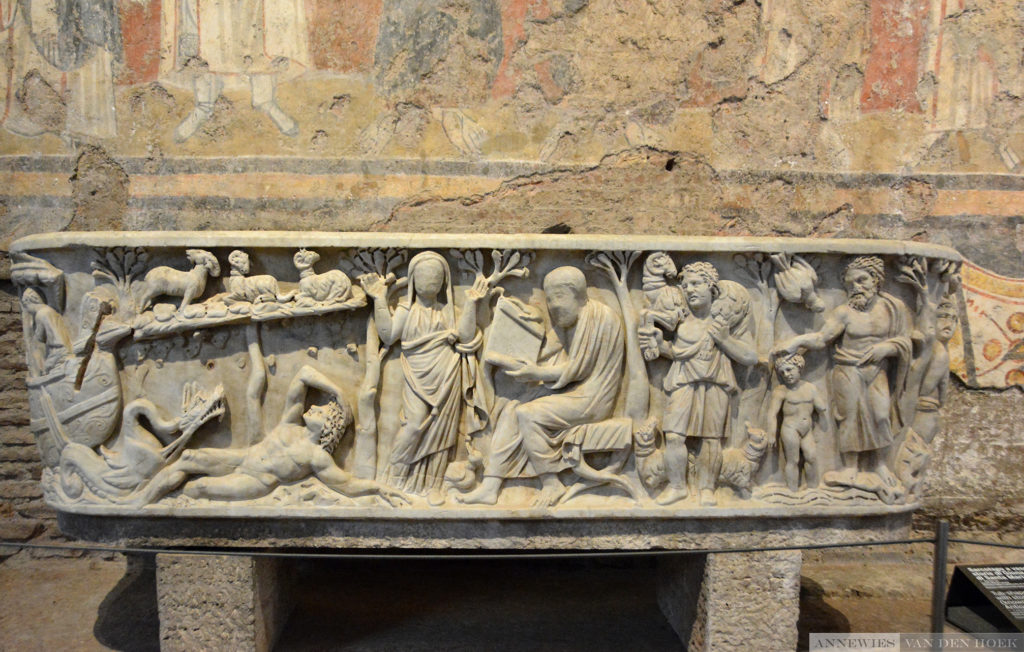Review of: Santino Alessandro Cugno. Dinamiche Insediative nel Territorio di Canicattini Bagni e nel Bacino di Alimentazione del Torrente Cavadonna (Siracusa) tra Antichita' e Medioevo. BAR International Series n. 2802, 2016 (in Italian). Publisher's link.
This volume is structured around a richly detailed presentation of topographical and archaeological data for human settlement in the area of a small city, today's Canicattini Bagni, located about 20 km southwest of Siracuse in Sicily. The author, Italian archaeologist Santino Alessandro Cugno, a Canicattini native, surveyed the territory around the Cavadonna river bed between 2008-2016 for material evidence to better document the chronology of the communities who have lived in these environs since prehistoric times.
The main body of the study concentrates on the period from which most of the ancient monumental remains can be dated, although not precisely, the Late Antique-Early Medieval eras (the book's upper chronological limit is around the time of the Islamic occupation of Sicily in the mid-9th century CE). Due to the very little archaeological excavation that has been conducted in the area to date, most of these monuments are funerary in nature: numerous, fairly accessible, but anonymous, with few exceptions, one of them being a possible menorah incised by a tomb in the interior of a rock cut chamber in the necropolis of Cugno Case Vecchie (tabel XXV.c). This is an amazing detail to recover, considering that the tombs continued to be vandalized and re-used over the centuries, leaving only the bare bones - pun intended - of their architectural form. As it so happens, Cugno and his collaborators were only able to document this decorative (and proprietary) feature in March of 2016 after it was reported in the local press, by means of special illumination techniques to bring out the distinct scratches in the wall, which, from their placement and distinctive design, do appear to be ancient. The menorah might be accompanied furthermore by other motifs common to Late Ancient Jewish proprietary contexts (tombs, community spaces such as synagogues, and on smaller objects, like gems, glassware, and seals) - Cugno cautiously proposes a shofar, an ethrog and perhaps a candle snuffer in the form of pincers - but from the photograph that accompanies the description, it is hard to tell. A tomb used by Jews and specifically marked as such has parallels in other nearby necropoli - the "Grotto del Carciofo" among the "Grotte dei Cento Bocche" at Noto Antica immediately come to mind, and Eastern Sicily holds others. Like virtually all the structures - funerary and otherwise - illustrated in Cugno's survey, this apparently Jewish tomb has never been excavated by archaeologists, though thanks to the efforts of Cugno and his collaborators from the Pontificia Commissione di Archeologia Sacra della Sicilia Orientale, a helpful site plan now exists (t. XXV, by Gioacchina Tiziana Ricciardi and Azzura Burgio). Curiously, Cugno places this tomb in the section devoted to Medieval monuments - even though it resembles the Late Ancient tombs in the previous chapter.
Under these circumstances, it is much appreciated that the author is honest about the limitations of documenting "dinamiche insediative" (settlement dynamics), because so few of the hundreds of sites described have ever been the focus of an archaeological campaign (Canicattini Bagni has lost out in this regard to nearby Syracuse and Palazzolo Acreide). Yet it is precisely this difficulty that makes this reader wish for a bit more graphic, i.e. visual assistance with the dense data collection. Cugno uses Google Earth Satellite Imagery to pinpoint individual sites, and for our GPS generation, this is a road trip in the making. The structural data, though, would have been helpful to present in tables within the text or in appendices in order to note trends and developments in tomb distribution and typology, an issue raised in many different sections of the book (and which will be also the focus of a future study), and to allow a reader greater familiarization with the list of all the ancient sites in Table II (they are not listed or distinguished in any other way along chronological lines, a seemingly missed opportunity to underline any shifts in settlement). The reader of a topographical survey should experience seeing as well as "believing" - as one certainly does, in the face of so much evidence; otherwise, this rich material must be mined once more to synthesize Cugno's own work (he has so much to say, that even in his concluding chapter, he presents new evidence!). Photos aside, it is a text-heavy work that a few graphic organizers or appendices might have lightened, especially for the sake of the non-Italian reader.
On the subject of evidence, the history of scholarship in the first part of the book is almost exclusively archaeological in nature. Together with the brief chapter on the area during the Middle Ages, this creates a sort of "Dark Ages" within the study for it is not clear how many avenues into archives (monastic/eccleasiastic, private, governmental) have been traveled for documentation on post-Antique land development. Italian bureaucracy though the ages no doubt has left more. In terms of more recent material, Cugno's work does make extensive use of the manuscript notes of Paolo Orsi (1859-1935), from the extreme north of Italy, in what was still the Austro-Hungarian Empire, and a pioneering researcher in the archaeology of his country's extreme other end, Sicily. The quotes from Orsi's journeys into the Canicattini territory - the details of the itinerary, the conversations and first impressions Orsi received of the sites - make more vivid Orsi's official accounts for the annual report of Notizie degli Scavi di Antichità. Though not discussed in Cugno's volume, which does not venture into Syracuse proper, Orsi studied the "Jewish tombs of the Cappuccini" and took note of "many Jewish testimonies on the island" (of Sicily). Like Cugno, Orsi saw this "Jewish evidence" originating in the east, in Syria-Palestine. New Testament peregrinations aside, it is clear that Eastern Sicily was populated by Jews in the Ancient and Medieval periods: material traces of their presence survive in the form of epitaphs, tomb decorations, small objects, and - possibly - one or more communal properties of the later middle ages featuring ritual baths. Like Orsi a century ago, we hold on to the hope that more Jewish artifacts will eventually be brought to light, as Cugno and his colleagues now appear to have done with the example of the menorah graffito at Cugno Case Vecchie. Together with original color photographs, a conscientious review of prior studies and new research, and a strong sense of mission to put his hometown on an equal footing with the neighboring sites of Syracuse, Palazzolo Acreide, Noto Antica, and other touristy towns, this discovery makes "Dinamiche Insediative" an exceptional point of departure for future exploration of Canicattini. Clearly, Cugno has awarded himself a life contract for such work.
- Reviewed by Jessica Dello Russo (7 September 2016)

